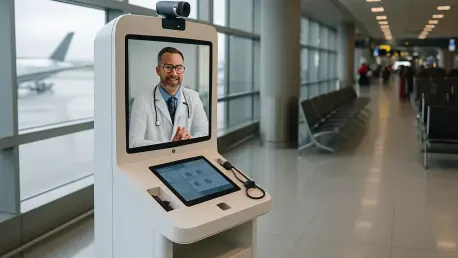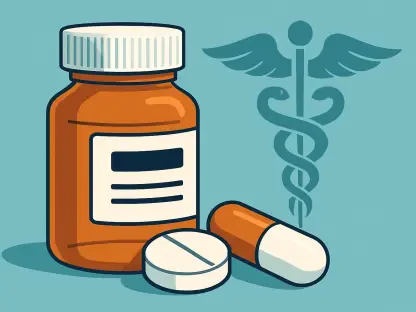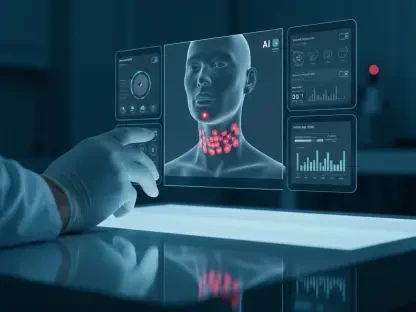In an era where convenience often dictates the pace of daily life, Bradley International Airport in Windsor Locks, Connecticut, has taken a remarkable step forward by introducing a telehealth kiosk through a partnership between Hartford HealthCare and OnMed. This innovative service, designed to cater to the needs of around 12,000 daily passengers and staff, addresses the unique challenges faced by those with unpredictable travel schedules or demanding work hours. Imagine a scenario where a traveler feels unwell just before boarding a flight, or an airport employee struggles to find time for a doctor’s visit between shifts. This new offering ensures that such hurdles no longer mean delayed care or unnecessary discomfort, providing a direct line to medical support right within the airport’s bustling environment.
The significance of this development stretches far beyond the terminal walls, pointing to a transformative shift in how healthcare is delivered. By embedding medical services in a high-traffic, nontraditional setting like an airport, the initiative reflects a growing recognition that accessibility must adapt to modern lifestyles. Located strategically in Terminal A, the kiosk stands as a beacon of immediate assistance, ready to tackle everything from minor ailments to urgent health concerns. For travelers and employees alike, this means not just convenience, but a newfound sense of security in an often unpredictable space.
Revolutionizing Healthcare Access
Bridging Gaps for Travelers and Staff
The core mission behind this telehealth initiative at Bradley Airport is to meet patients exactly where they are, both physically and in terms of their hectic schedules. Deb Hayes, Chief Integration Officer at Hartford HealthCare, emphasizes that the program is crafted to serve passengers who might face sudden health issues mid-travel, as well as airport workers whose irregular hours often clash with traditional medical appointment slots. This approach flips the conventional model on its head, eliminating the need for individuals to carve out time or travel to distant clinics. Instead, care is brought directly to a place of constant movement and demand, ensuring that a sore throat or unexpected fatigue doesn’t escalate into a larger problem due to lack of access. The result is a system that prioritizes immediacy, catering to the unique rhythm of airport life.
Empowering On-the-Go Care
Beyond simply filling a logistical gap, this telehealth service represents a broader commitment to empowering individuals with control over their health, no matter the circumstances. For someone catching a connecting flight, the ability to consult a clinician without leaving the terminal can mean the difference between continuing a journey or facing costly delays. Similarly, airport employees, often bound by rigid shift patterns, gain a practical solution that fits into their workday without requiring time off or complex coordination. This initiative underscores a pivotal shift in healthcare philosophy—moving away from expecting patients to adapt to rigid systems and toward creating flexible, responsive options that align with real-world needs. By focusing on accessibility in such a dynamic environment, the program sets a precedent for how medical care can evolve to match the pace of modern life.
Technology and Design Behind the Kiosk
Cutting-Edge Tools for Virtual Care
At the heart of the telehealth kiosk in Bradley Airport lies an impressive array of technology designed to replicate the depth of an in-person doctor’s visit. Housed in a sleek, self-contained unit in Terminal A, the setup boasts a 65-inch screen for virtual consultations, alongside diagnostic equipment such as a thermal scanner, blood pressure cuff, pulse oximeter, stethoscope, and high-definition camera. These tools enable clinicians to assess and treat up to 85% of common primary care conditions, ranging from respiratory issues to allergies and even mental health screenings. A typical virtual visit lasts about 20 minutes, concluding with tailored treatment plans or electronic prescriptions sent to a pharmacy of choice. This technological sophistication ensures that users receive comprehensive care without stepping foot outside the airport, blending efficiency with quality in a way that feels almost futuristic.
Prioritizing Privacy and Hygiene
Equally important to the functionality of the kiosk is its thoughtful design, which addresses potential concerns about using a shared medical space. Features like fogging glass provide privacy during consultations, shielding users from the curious eyes of passersby in a busy terminal. Meanwhile, hygiene is meticulously maintained through antimicrobial materials, an air purification system, and UV-C light sanitization between sessions. These measures respond to heightened awareness of cleanliness in public spaces, ensuring that each interaction feels safe and secure. Whether it’s a traveler worried about catching a flight while unwell or an employee seeking a discreet check-up, the kiosk offers a sanctuary of care that balances cutting-edge capability with the reassurance of a protected environment. This focus on user comfort elevates the experience beyond mere convenience.
A Growing Trend in Nontraditional Settings
Expanding Telehealth to Everyday Spaces
The introduction of a telehealth kiosk at Bradley Airport is not an isolated innovation but part of a sweeping trend to integrate healthcare into everyday, nonclinical environments. Hartford HealthCare has already implemented similar OnMed kiosks at locations like a Stop & Shop in Killingly and the Village for Families and Children in Hartford, demonstrating a strategic push to reach communities where they live and work. Elsewhere, other providers are following suit by placing telehealth services in pharmacies, libraries, schools, and even major retailers like Walmart. This movement reflects a consensus that medical access should no longer be confined to hospitals or clinics but extended to high-traffic areas where people naturally congregate. By embedding care in such spaces, barriers of time and distance are dismantled, making health support as routine as a grocery run or a trip through an airport.
Redefining Convenience in Healthcare
This trend toward nontraditional settings also signals a redefinition of what convenience means in the healthcare landscape. At Bradley Airport, the telehealth kiosk caters to a transient population whose needs often fall through the cracks of conventional systems—travelers who can’t wait days for an appointment and staff who can’t easily leave their posts. Similar initiatives in retail or community hubs target other underserved groups, such as rural residents or busy professionals, ensuring that care aligns with daily routines rather than disrupting them. The broader implication is a democratization of health services, where technology serves as a bridge to connect people with clinicians in real time, regardless of location. As these models proliferate, they challenge the industry to rethink how and where care is delivered, paving the way for a more inclusive and adaptable framework.
Systemic Impact on Healthcare Delivery
Reducing Strain on Hospital Systems
One of the most compelling advantages of the telehealth kiosk at Bradley Airport is its potential to alleviate pressure on overburdened hospital systems. Deb Hayes points out that many individuals who use the kiosk might otherwise seek treatment in emergency rooms for non-urgent issues like minor infections or headaches. By offering an alternative that’s both timely and cost-effective, the service redirects these cases to a more suitable level of care, freeing up emergency resources for critical situations. This shift not only benefits patients through shorter wait times and lower expenses but also supports healthcare infrastructure by distributing demand more evenly. The ripple effect could be significant, as such initiatives scale to other high-traffic locations, potentially transforming how routine medical needs are managed on a systemic level.
Enhancing Cost-Effective Care Options
Another layer of impact lies in the affordability and efficiency that telehealth kiosks bring to the table. For travelers and airport employees, accessing a virtual consultation at the point of need eliminates the financial and logistical burden of seeking care elsewhere, whether that’s through expensive urgent care visits or disrupted travel plans. The streamlined 20-minute sessions, complete with immediate treatment plans or referrals, ensure that health concerns are addressed without unnecessary delays or costs. On a broader scale, this model suggests a future where healthcare systems can operate more sustainably by prioritizing accessible, preventive interventions over reactive, high-cost solutions. As telehealth continues to expand into unconventional spaces, it offers a blueprint for balancing quality care with economic pragmatism, benefiting both individuals and the industry as a whole.
Reflecting on a Milestone in Accessibility
Looking back, the launch of the telehealth kiosk at Bradley Airport marked a pivotal moment in reimagining healthcare delivery for transient and time-constrained populations. It showcased how technology, when paired with strategic placement, could address immediate needs while setting a standard for innovation in accessibility. The success of this program hinted at untapped potential for similar solutions in other bustling hubs. Moving forward, stakeholders should consider scaling such initiatives, exploring user feedback to refine technology and privacy measures, and partnering with diverse venues to reach even more communities. The journey that began in a Connecticut terminal could inspire a nationwide network of on-the-spot care, ensuring that no one is left behind due to the constraints of time or place.









